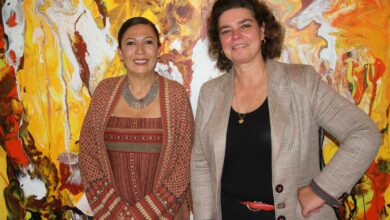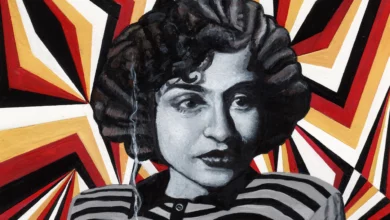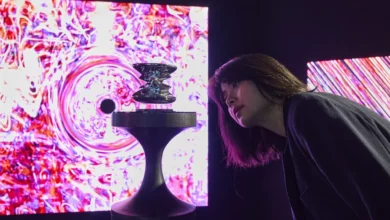At the 20th Youth Salon in 2009, selected sculptures were displayed together on a stand at the exhibition hall, in a gesture that relayed more than just the creativity and meaning embedded in the artwork.
An independent jury that included international art practitioners vested in debates about the meaning of contemporaneity selected a few sculptures and aggregated them on one stand. Cynics criticized them for downgrading sculpture–an art form entrenched in local heritage–and accused them of blind westernization that favors the contemporary over the authentic. While jurists spoke of a strategic mode of exhibition aimed at interrogating sculpture as an artistic practice, cynics who consider sculpture an embodiment of authentic Egyptian art wondered why the medium wasn’t particularly omnipresent in the salon.
This cultural war represents a larger crisis in the state of the arts in Egypt. It prompted debates about the country’s quest for modernity, the relationship between politics and artistic creativity, and the role of art in post-colonial state-building, among other issues. In this context, sculpture isn’t just a tool for artistic expression; it’s also a political instrument.
“All mediums are politicized especially when they become public discourse. The discussion around sculpture is especially pertinent because it is a form that is associated with pharaonic heritage and is thus used by multiple parties as an index of Egyptian identity,” says Hassan Khan, a visual artist.
Echoing this opinion, independent curator Aleya Hamza describes sculpture as a loaded medium. “[Sculpture] carries the burden of history. Whatever material you use, whatever form you make, it immediately has very strong references to art history, from the pharaohs to the minimalists.”
Authentic and contemporary
Sculpture is one the sites where the debate about authenticity (asala) versus contemporaneity (mu’asara) thrives; a debate that remains deeply relevant to the politics of art in Egypt. However, there is a pressing need to unpack this binary.
Many in this debate celebrate sculpture as an authentically Egyptian art form. Such an essentialist position turns sculpture into an instrument for the construction of a national identity and promotes a nostalgic reliance on the past in order to validate the present. “The idea that there is any connection between our contemporary life and pharaonic times is laughable and naïve. It is an extremely obvious ideological ploy to help construct a national identity with a clear sense of origin. All hegemonic power systems that function under the guise of the nation-state are constantly involved in the replication of this construction in all details from the school textbook to how we deal with art,” says Khan.
Khan finds assigning an intrinsically Egyptian or local nature to sculpture a dangerous myth. “It is dangerous because it transforms the artist into a propagandist and therefore by extension it reduces our understanding of art to propaganda. It falsifies the world around us into a series of banal statements about a fabled past and fictional future.” This propaganda in many cases means that art becomes a tool in the production of idealized one-dimensional images of Egypt and the Egyptians, he says. He reminds us that all cultures are hybrid, a fact which puts into question concepts of authenticity and by extension rigid understandings of identity.
Hamza calls for moving past this debate of the authentic versus the contemporary. “With the more traditional art forms like sculpture, perhaps it’s harder to escape that debate because of the limitation inherent in the medium itself and its loaded history. But for me, it’s not that relevant. I’m personally not interested in artwork that is completely formalist. I’m more interested in works that have relevance, urgency and impact, and that’s what makes it contemporary. And, of course, that’s what also makes it potentially subversive.”
Contemporary practices: Stepping beyond
Despite the prevalence of this debate, as showcased in last year’s Youth Salon, sculpture is evolving as a contemporary practice in different contexts.
The Aswan International Sculpture Symposium is at times a home for such practices. Established in 1996 as a collaborative venture between the Ministry of Culture and the Aswan Governorate, the symposium has witnessed interesting projects crossing between sculpture and architecture. It is directed by renowned sculptor Adam Henein who returned to Egypt after 20 years of residence and artistic practice in France.
Khaled Hafez, a visual artist, considers the symposium a salvation for sculpture practices in Egypt. “[The symposium] solved almost all of the sculpture problems at the time, giving opportunities to young and old sculptors alike to work, produce, get paid, and store [works] in an open air museum and get away from critical discourses that do not serve art,” he says. “In the early 1990s, it was noticed that young sculptors who undertook formal studies in the fine art schools were continuously abandoning sculpture for various reasons, most important of which are the cost and messiness of production,” Hafez adds. He mentions the lack of storage spaces and sculpture studios that cater to old and young artists alike.
Walid Fathi, a 25-year-old artist, partook for the first time in the Aswan International Sculpture Symposium in January of this year and calls it a transformative experience. Fathi sculpted a flying bird using grey granite to depict the moment when a bird takes off to fly. Fathi says he is attracted to horizontal structures. “It’s in my subconscious. While a vertical structure gives a sense of resistance, horizontal structures give a different sense of resistance. I started relating between horizontal and horizon. Your eyes continue with the shape as if it’s an arrow directing you to the horizon. There is always one point you gaze at, but once you seem to reach it, it extends, like infinity,” he says.
Hafez, who mentors Fathi, appreciates the production conditions made available to the young artist through the symposium, most importantly the creation of a platform for an autonomous practice. “The protrusions in [Fathi’s] work are attempts for an inert mass to escape from its own form; such personal subjects had to find a way two decades ago, when discourse was authenticity versus contemporaneity.”
Besides the symposium, other multi-layered sculptural practices have also evolved, deconstructing notions of old versus modern. The work of Tarek Zaki, a 35-year-old visual artist, is a case in point, suggests Hamza. “In his project Monument X, he literally deconstructs a fake monument-like structure into its basic sculptural components, stripping it of its very monumentality. It’s like taking the sculpture off the pedestal, which is its most traditional incarnation.” Hamza highlights Zaki’s strategic questioning of canonization and monumentality in art and history. “He often makes the viewers conscious of the historical moment that they are in,” she says.
Khan cites other possible practices, proposed by sculptors, that can transcend the “fetishization of the medium” and the assumption that an artist is defined by the medium he/she uses (hence only a craftsman rather than an instigator or producer of meaning). He points, for example, to experiments in treating sculptures as “forms in space.” He refers to visual artist Sherif el-Azma’s architectural models of Pink Floyd’s concert venue at the roman theater in Pompeii. In those sculptural models, “the work evokes the heroic poses of contemporary pop culture trends–like rock music–and their relation to daily spectacle and its influence upon its consumers and their self image, especially youngsters,” Khan says.
He also gives as an example artist Mona Marzouk’s hybrid architectural forms, including a sculpture in which a mosque’s minaret is attached to a Roman amphitheater. "[They] helped break the idea of sculpture as either a mimesis of nature or an abstraction that proves the artist’s skill. In her pieces we see again the elements of our daily life and cultural history reconfigured in an extremely rigorous and precise formal language.”
Artist Shady el-Noshokaty’s megaphone and sound assemblages represent another experiment with sculpture as form and mediator of meaning. “[They] powerfully rework the sculpture as a totem of our daily aural soundscape; it is as if the ephemeral sphere of sound has suddenly found a concrete form for itself,” says Khan.
Such works and others debunk the limitations placed on sculpture as a bearer of local heritage. Instead, they reinvent the medium’s potential and–most importantly–redefine the role of the artist.




